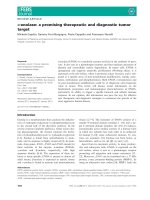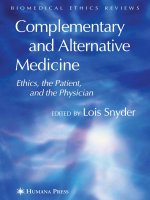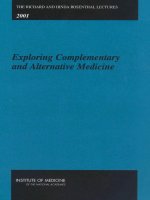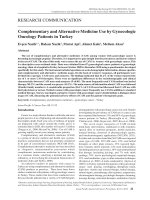Bayesian biostatistics and diagnostic medicine
Bạn đang xem bản rút gọn của tài liệu. Xem và tải ngay bản đầy đủ của tài liệu tại đây (856.18 KB, 20 trang )
<span class='text_page_counter'>(1)</span><div class='page_container' data-page=1>
HOÀNG VĂN VÂN (Tổng chủ biên) – NGUYỄN THỊ CHI (Chủ biên)
LÊ KIM DUNG – PHAN CHÍ NGHĨA – LƯU QUÝ KHƯƠNG
VŨ MAI TRANG – LƯƠNG QUỲNH TRANG
Với sự cộng tác của DAVID KAYE
TẬP MỘT
<b>BỘ GIÁO DỤC VÀ ĐÀO TẠO</b>
</div>
<span class='text_page_counter'>(2)</span><div class='page_container' data-page=2></div>
<span class='text_page_counter'>(3)</span><div class='page_container' data-page=3>
<b>,1752'8&7,21</b> ...4
<b>81,70<1(:6&+22/</b> ...10
<b>81,70<+20(</b> ...30
<b>81,70<)5,(1'6</b> ...50
<b>5(9,(:</b> ...70
<b>81,70<1(,*+%285+22'</b> ...74
<b>81,71$785$/:21'(562)7+(:25/'</b> ...94
<b>81,72857(7+2/,'$<</b> ...114
</div>
<span class='text_page_counter'>(4)</span><div class='page_container' data-page=4>
<b>4</b> INTRODUCTION
INTRODUCTION
<b>TIẾNG ANH 6</b>isthe fi rst of a four-level English language textbook for Vietnamese students of
lower secondary schools learningEnglishasa foreign language (EFL). It followsthe systematic,
cyclical and theme-based syllabusapproved by the Ministry of Educationand TraininginOctober
2011, which focuses onthe use of language (pronunciation, vocabulary, and grammar)to develop
the four language skills(listening, speaking, readingand writing).
<b>THE COMPONENTS OF THE TEXTBOOK</b>
The complete learningset of <b>TIẾNG ANH 6</b> consists of <b>THE STUDENT’S BOOK</b>, <b>THE </b>
<b>TEACHER’S BOOK an</b>d <b>THE WORKBOOK.</b>
<b>THE STUDENT’S BOOK</b>
The Student’s Book contains:
• the book map: Introducingthe basics of each unit
• 12 topic-based Units, each covering 8 sectionsto be taughtinseven 45-minute lessons
• 4 Reviews, each providing revisionand further practice of the previousthree units, to be
dealt withintwo periods
• Glossary: giving meaningand phonetic transcription of the new wordsinthe units
<b>THE TEACHER’S BOOK</b>
The Teacher’s Book gives full procedural notes for teaching diff erent parts of each unit. The
answer keysto the exercisesinthe Student’s Book and the transcriptionsare also giveninthe
Teacher’s Book.
<b>THE WORKBOOK</b>
The Workbook mirrorsand reinforcesthe content of the Student’s Book. It off ers:
• further practice for the language and skillstaughtin class, and
• four additional tests for students’ self-assessment.
<b>THE CD</b>
<b>THE COMPONENTS OF EACH UNIT</b>
There are 12 main units in the Student’s Book. Each unit has eight sections, providing
material for 7 classroom lessons of 45 minutes. These 12 richly illustrated, cross-curricular and
theme-based units focus on off ering students motivation, memorable lessonsand a joyful
learning experience. Atthe beginning of every unit, there are explicit learning contents clearly
</div>
<span class='text_page_counter'>(5)</span><div class='page_container' data-page=5>
<b>SECTION 1: GETTING STARTED</b>
Thissection occupiestwo pagesand itis designed for one 45-minute lessonin class. Itbegins
witha conversation followed by the activities whichintroducesthe topic of the unit; itthen
presentsthe vocabulary and the grammar itemsto be learned and practised throughthe skills
and activities of the unit.
<b>SECTION 2: A CLOSER LOOK 1</b>
ACloser Look 1 and ACloser Look 2 are each designed to be taughtin one 45-minute period.
AClose Look 1 presentsand practisesthe vocabulary and pronunciation of the unit. The
active vocabulary of the unitisgiveninaninterestingand illustrated way so thatitis easy
for studentsto memorise. Two or three sounds, whichappear frequently inthe unit, are
givenand practised inisolationand in context. There are different exercises focusing on
intensive practice of vocabulary and pronunciation.
Agrammar item may also be included inthissection.
<b>SECTION 3: A CLOSER LOOK 2</b>
This sections deals with the main grammar point(s) of the unit. The new language point is
presented inashorttext or atalk/interview. There are clearly explicitgrammar tablesand exercises
whichare well illustrated to help students remember and use the grammar items eff ectively. The
‘Remember’ boxesappear wherever necessary and help studentsto avoid common errors.
ACloser Look 1 and ACloser Look 2 cover three pages; they mainly give language focusand
practice of receptive skills.
<b>SECTION 4: CULTURE & COMMUNICATION</b>
This section is designed to help students use the functional language in everyday life
contextsand consolidate whatthey have learned in the previoussections. Italso gives
students opportunitiesto learnand apply the cultural aspects of the language learntto
their lives, and provides cultural informationaboutVietNam and other countriesinthe
world. The vocabulary is clearly presented inboxes wherever itisneeded.
<b>SECTION 5: SKILLS 1</b>
Skills 1 and Skills 2 each covers one page and is designed to be taught in one 45-minute
period. Skills 1 comprises reading(receptive skill)and speaking(productive skill).
<b>5HDGLQJ</b>
Thisactivity aimsto develop students’ readingabilities. The readingtextis oftenbased on
the vocabulary and structuresthatstudentshave previously acquired to make the activity
achievable. Itisalwaysinterestingand relevantto the students, and links withthe topic of the
unit. Importantnew vocabulary isintroduced inthe textand practised ina follow-up activity.
The readingalso providesinput for the speakingthat follows.
<b>6SHDNLQJ</b>
Thisactivity aimsto provide further practice which supports students intheir production
</div>
<span class='text_page_counter'>(6)</span><div class='page_container' data-page=6>
<b>6</b> INTRODUCTION
<b>SECTION 6: SKILLS 2</b>
Skills 2 is composed of listening(receptive skill)and writing(productive skill).
<b>/LVWHQLQJ</b>
The listeningactivity followsthe oral practice in Speakingto provide studentsan opportunity
to listento the language thatthey have practised orally and trainthem to listen for general
and specifi c information.
<b>:ULWLQJ</b>
Thissection focuses on developingstudents’ writingskills. Itnormally involves one of the
texttypes required for the Students' skill development. There isa writingtip or aguideline
whichis very useful to help them to write eff ectively. The result of the writingactivity must
be a complete piece of writing, and ideally itis marked by the group/ class/ teacher.
<b>SECTION 7: LOOKING BACK & PROJECT</b>
Thissection coverstwo pagesand should be dealt within one period.
Looking back recycles the language from the previous sections and links with the topics.
Variousactivitiesand exercisesare designed to help students consolidate and apply whatthey
have learntinthe unit. Throughthe students’ performance of thissection, teachers can evaluate
their study resultsand provide further practice if necessary.
The projecthelpsstudentsto improve their ability to work by themselvesand inateam, and
extend their imaginationina fi eld related to the unitsubject. The teacher can use thisasan
extra-curricular activity (for groupwork) or ashomework for studentsto do individually.
<b>REFERENCE ON SKILLS AND LANGUAGE TEACHING</b>
<b>1. TEACHING READING</b>
Readingisthe fi rst of the four language skillsthat receivesspecial attentionin<b>Tiếng Anh 6</b>.
- The readingactivitiesin<b>Tiếng Anh 6</b>aim to help students develop sub-skillssuchas
skimming for gistand scanning for details.
- In developing readingskills, studentsare taughtto read aloud, followingthe picturesand
the textsinthe Student’s Book. This providesanimplicit opportunity for studentsto practise
their pronunciationand intonation.
- Explanationsshould be givento students whenthey do not understand the meaning of
a word. Some reading strategiessuchas focusing on familiar words, guessing unfamiliar
wordsina logical context, etc. should be taughtto students.
- Before teachingthe text, the teacher should encourage studentsto guess whatthe textis
about, whatnew words will appear inthe text, etc.
<b>2. TEACHING SPEAKING</b>
Speaking in<b>Tiếng Anh 6</b>is of two forms: spoken interaction and spoken production. The
fi rst refersto the ability to ask and answer questionsand handle exchanges with others. The
</div>
<span class='text_page_counter'>(7)</span><div class='page_container' data-page=7>
Speakingactivitiesshould include :
- Pronunciation: thisis practised through dialogues, games, rhymesand songs. Throughthese
forms, students practise the stress, the rhythm and the intonation patterns of Englishina
natural way. Itis crucial to provide students with lots of modelsand to build up their confi dent
acceptance of approximate correct pronunciation.
- Repetition: thishelpsstudentsto memorise vocabulary and ‘chunks’ of language. Repetition
and classroom routinesbuild up an expanding repertoire of Englishthathelpsstudents
understand and respond to a situationas a part of communicative interactionsin class.
The beststrategy isto provide lots of opportunities for studentsto practise withasecure
feeling through choral repetition of action rhymes and games. It is also important to
establishsome classroom routinessuchasgreetingsand sayinggoodbye atthe beginning
and the end of the lessons, asking for permission, saying common classroom expressions
suchas<i>I don’t understand</i>. <i>Could you say it again, please? May I ask you a question?</i> or answering
a question, <i>I don’t know. I think/guess ...</i>, and <i>Perhaps ...</i>
- Pair work/ group work and class presentationshelp studentsto talk freely ina language
situation related to the topic of the unit. Thisalso makesstudents feel secure and promotes
their confi dence inspeaking.
Error correction should be done cautiously by the teacher. When students are talking,
teachersshould notstop them to correcttheir mistakes. Mistakesshould be analysed and
only repeated onesshould be givenafterwardsand corrected collectively.
<b>3. TEACHING LISTENING</b>
Through listening, students become familiar with the sounds, rhythms and intonation of
English. When listeningto English, studentsare actively engaged in constructing meaningand
makingsense of whatthey hear, usingtheir knowledge and the clues provided by the context.
So itis very importantto teachstudentsto be aware of the reason for and purpose of listening,
the content of the listeningtextand the speaker’s voice.
Before listening, teachersshould motivate and engage studentsinthe listeningactivity;
encourage them to predict the listening content, and introduce the new language or
vocabulary which occursinthe listeningtext.
The listeningactivity should aim to help students understand spokenEnglishand develop
sub-listeningskillssuchas listening for gist or listening for details.
After listening, studentsare to show their listening comprehensionin front of the class, and to
provide a follow-up spoken/writtenactivity suchasspeaking, or writing down whatstudents
have listened to.
<b>4. TEACHING WRITING</b>
The writingactivity aimsto develop students’ basic writingskillsinEnglish. Its emphasisis on
providing writingtechniques for a particular genre: e-mail, aninformal letter, a webpage for
example as well as practisingthe spelling of familiar vocabulary and sentence patterns. Teaching
writing canbe divided into three stages: <i>before writing, while writing</i>and <i>after writing</i>.
</div>
<span class='text_page_counter'>(8)</span><div class='page_container' data-page=8>
<b>8</b> INTRODUCTION
- <i>While writing</i>helpsstudents work independently under the teacher’sguidance and supervision.
- <i>After writing</i>helpsstudents consolidate their writingskillsthrougha follow-up activity
suchas makinga draft, copyingthe draftinto students’ notebooks or ona cleansheet of
paper, focusing onneatness, spelling, punctuation, use of words, sentence structures, and
organisation of the writing.
<b>5. TEACHING PRONUNCIATION</b>
Teaching pronunciation consists of teaching phonetics(soundsinisolationand in context),
rhymes, chants, and songs. Withthe knowledge of phonicsstudentshave learned in previous
years, studentsare able to improve their speakingand readingskillsbecause they canidentify
the spelling and pronunciation patterns of listening texts and decode them quickly. The
teacher should focusstudents’ attention onthe letter(s)and its/ their sound(s)in words, and
model the new soundsa few times for studentsto repeat.
In teaching pronunciationitisadvisable thatthe teacher should introduce the contextin
whichthe new soundsare embedded; teachnew vocabulary, using fl ashcards, pictures, etc;
and mime the linesif possible; focusstudents’ attention onthe letter(s)and its/their sound(s)
a few times for studentsto repeat; play the recordinga few times, havingstudents repeat each
line of the song/rhyme/chantand clap the words containingthe focused sounds; organise
studentsto work in pairsand groupsto practise the song/ rhyme/ chant; and call onsome
volunteersto perform the song/rhyme/chantatthe front of the class.
<b>6. TEACHING VOCABULARY</b>
Teaching vocabulary helpsstudents understand, memorise and use wordsappropriately in
their specifi c contexts. Studentsat lower secondary level still learn chunks of English which
combine vocabulary and grammatical patternsinan unanalysed way. Therefore, itis crucial to
give students plenty of time to practise, memorise, recycle, and extend their vocabulary and
grammar in meaningful contexts. Regular recycling of vocabulary helpsstudents meetthe
same words embedded in diff erent contextsand activitiesagainand again. When teaching
vocabulary, itisimportantto help students recognise, practise and memorise vocabulary.
These canbe done by using visual aids, by allowingstudentsto listenand repeatthe word,
by explainingtheir meaning, using defi nitions, pictures, fl ashcards, and translationif necessary;
and fi nally, gettingstudentsto practise, usingthe word witha range of spoken or written
activities which canbe done individually or in pairs.
<b>7. TEACHING GRAMMAR</b>
Teachinggrammar helpsstudents use correctgrammatical patternsto expresstheir ideasin
specifi c contexts.
Grade 6 students of Englishalready know some Englishgrammar based on formulaic sequences
and a lot of grammar points metinthe context of dialogues, readings, chants, rhymes, stories
and songsthey have learntin primary schools.
</div>
<span class='text_page_counter'>(9)</span><div class='page_container' data-page=9>
- focusingstudents’ attention onthe new grammatical patternsinthe texts
- providing models for studentsto practise the new grammatical item inaspoken or written
activity, usingthe cued pictures or promptsintheir books
- reinforcingthe new grammatical item witha variety of spokenand writtenactivities
<b>8. PAIR WORK/ GROUP WORK</b>
Students should be given clear instructions about whatthey are expected to do and say.
The followingare some suggested teachingsteps.
- <i>Whole class</i>. Elicit/ Teach/ Model the focus language (words, phrases or structures). Then
write them onthe board.
- <i>Model</i>. Perform the focus materials yourself or ask a pair to demonstrate in front of the class.
Help and guide them to interactina reasonably structured manner. This will enable the
freer stage of independent pair work/group work that will follow.
- Students practise in pairs or groups. Monitor the activity and off er help if necessary.
- Ask a confi dent pair or some volunteersto perform the task for the rest of the class.
- <i>Whole class.</i>Atthe end of the activity, there should be some writingactivity to reinforce or
consolidate students’ understanding.
<b>It is noted that all of the procedures written in this book are only suggestions. </b>
</div>
<span class='text_page_counter'>(10)</span><div class='page_container' data-page=10>
<b>10</b> Unit 1/ My New School
<b>8QLW</b>
<b>W</b>
<b><sub>0<1(:6&+22/</sub></b>
<b>*(77,1*67$57('</b>
<i><b>Phong:</b></i> Oh, someone’s knockingatthe door.
<i><b>Phong’s Mum: Hi</b></i>, Vy. You’re early. Phong’s
havingbreakfast.
<i><b>Vy: </b></i> Hi, MrsNguyen. Oh dear, I’m sorry. I’m
excited about our fi rst day atschool.
<i><b>Phong’s Mum:</b></i>Haha, Isee. Please come in.
<i><b>Vy: </b></i> Hi, Phong. Are you ready?
<i><b>Phong: </b></i>Yes, justa minute.
<i><b>Vy: </b></i> Oh, Ihave anew friend. ThisisDuy.
<i><b>Phong: </b></i>Hi, Duy. Nice to meet you.
<b>$VSHFLDOGD\</b>
<i><b>Duy: </b></i>Hi, Phong. Nice to meet you too. I live here
now. Igo to the same school as you.
<i><b>Phong:</b></i> That’sgood. School will be great – you’ll see.
Hmm, your schoolbag looksheavy.
<i><b>Duy: </b></i>Yes, itis. Ihave new notebooks, anew
calculator, and new pens.
<i><b>Phong: </b></i>And you’re wearingthe new uniform Duy.
You look smart!
<i><b>Duy: </b></i>Thanks, Phong.
<i><b>Phong: </b></i>Let me put on my uniform too. Then we cango.
<i><b>Vy:</b></i> Sure, Phong.
<b></b>
<b>Listen and read. </b><b>THIS UNIT INCLUDES:</b>
<b>VOCABULARY</b>
<b>School things and activities </b>
<b>PRONUNCIATION </b>
<b>Sounds </b><i><b>/ə</b></i> <i><b>/ </b></i><b>and</b><i><b><sub> / /</sub></b></i>
<b>GRAMMAR</b>
<b>The present simple and the pr</b>
<b>esent continuous</b>
<b>Verb </b><i><b><sub>(study, have, do, play)</sub></b></i>
<b> + Noun</b>
<b>COMMUNICATION</b>
<b>Talking about and describing a school </b>
<b>Talking about and describing school ac</b>
</div>
<span class='text_page_counter'>(11)</span><div class='page_container' data-page=11>
<b>,QWURGXFWLRQ</b>
<b>As it is the fi rst lesson of the school year, T should let Ss introduce themselves and/ or </b>
<b>introduce some warm-up activities.</b>
<b>Focus on the characters, Phong, Vy and Duy, and the key language and structures to </b>
<b>be learnt. Write the title on the board ‘A special day’. Explain the meaning of ‘special’ </b>
<b>and ask Ss to guess what the picture might show or what the conversation might be </b>
<b>about. Let Ss open their books and check their answers.</b>
<b>2EMHFWLYHV</b>
<b>By the end of this unit, students can:</b>
pronounce correctly the sounds /<i><b>ə</b></i> <i><b>/ </b></i>and <i><b>/ /</b></i>inisolationand in context
use the lexical items related to the topic <i><b>‘</b></i>My New School<i><b>’</b></i>
use the combinations: <i>to study, to have, to do, to play</i> + Noun
use the presentsimple and the present continuous
ask appropriate questions when makingnew friendsatanew school
read for specifi c informationaboutschools, and read e-mailsand webpages
talk aboutschool activities, subjects, and what Ss do atschool
listento getinformationaboutschool activities
write a webpage for their school, using correct punctuation
<b></b>
Ask Ss questionsaboutthe picture:<i>E.g.What is Phong doing? Who are Vy and Duy?</i> …
Ask Ss why itisaspecial day.
Play the recording. Ss listenand read.
<b>*(77,1*67$57('</b>
<b>$VSHFLDOGD\</b>
</div>
<span class='text_page_counter'>(12)</span><div class='page_container' data-page=12>
<b>12</b> Unit 1/ My New School
<b>D</b>
<b></b>
<b>E</b>
<b>F</b>
<b>Are these sentences true (T) or false (F)?</b>
<b></b>
<b>Match the words with the </b><b>school things. Then listen </b>
<b>and repeat.</b>
<b>1.</b> Oh dear. <b>2.</b> You’ll see.
<b>3.</b> Come in. <b>4.</b> Sure.
<b>Find these expressions in the conversation. </b>
<b>Check what they mean.</b>
<b>1.</b> Vy and Duy are early.
<b>2.</b> Phongis eating.
<b>3.</b> Duy isPhong’s friend.
<b>4. </b> Duy livesnear Phong.
<b>5.</b> Phongis wearingaschool uniform.
<b>Work in pairs. Create short role-plays with </b>
<b>the expressions. Then practise them.</b>
<i><b>Example:</b></i>
A: <i>Oh dear</i>. I forgot my calculator.
B: That’sOK, you canborrow mine.
A: Thank you.
<b>C</b>
<b>an you extend </b>
<b>your conversation?</b>
Get up, Nam
Get up, Nam
You’re going back to school
Your friends are going back to school, too.
The new school year starts today.
You’ve got nice shoes
You’ve got new pens
Your friends are on their way.
<b>1. </b>________________
<b>2.</b>________________ <b>3. </b>________________ <b>4.</b>________________
<b>5.</b>________________ <b>6.</b>________________ <b>7. </b>________________
<b>8.</b>________________ <b>9. </b>________________ <b>10.</b>________________
a. bicycle
b. pencil sharpener
c. calculator
d. rubber
e. compass
f. notebook
g. ruler
h. textbook
i. pencil case
j. schoolbag
<b>Look around the class – what other things do </b>
<b>you have in your classroom? Ask your teacher.</b>
<b>D</b> <b>Work in pairs. Write a poem </b>
<b>about your partner. Use the </b>
<b>poem above to help you.</b>
<b>E</b> <b>Now read the poem to your </b>
<b>partner.</b>
<b></b>
<b>Listen and read the following poem.</b><b>Learning tip</b>
<b>D</b>
<b>raw pictures next to new words </b>
<b>in your vocabulary book.</b>
<i><b>Example: </b></i>
</div>
<span class='text_page_counter'>(13)</span><div class='page_container' data-page=13>
<b>D</b>
Ss work independently. Allow them to share answersbefore discussingingroups or asa class.<i><b>Key:</b></i> <b>1.</b>T <b>2.</b> T <b>3.</b> F <b>4.</b> T <b>5.</b> F
<b>E</b>
Tell Ssto refer back to the conversationto fi nd the expressions. Practise sayingthem together (play therecordingagainif necessary). Explainthe meaning(or give synonyms)to Ss, thengive some examples.
<i><b> Key:</b></i>
<b>1.</b> used to expresssurprise (negative) <b>2.</b>tYou’ll fi nd outu
<b>3. </b>used to invite sbin <b>4.</b> used to say tyesu/ talrightu
<b>F</b>
Ask Ssto role-play the short conversationsin pairsbefore creatingshort role-plays.More able Ss cantry to extend the conversation.
<b></b>
Play the recording. Let the whole class read the poem with the right intonation and rhythm.Ask questionsto check Ss’ understanding of the poem. Then Ss work in pairsand write a poem about
their partner, then read the poem aloud.
<i>Example: </i>
Khanhisgoingback to school today.
His friendsare goingback to school, too.
Hisnew school year startstoday.
He’sgotanice schoolbag.
He’sgotanew bike.
His friendsare ontheir way.
………..
<b></b>
Ask Ssto matchthe words withthe school things. Play the recording. Ss listenand repeat. Then letthempractise sayingthe names of school things. Help explainthe meaningif necessary, e.g. use visual aids
inthe classroom. Thenask Ssto write the correct wordsinthe spaces. Allow Ssto check their answers
(in pairs or ingroups).
<b> </b> <b>1 - b</b> pencil sharpener <b>2 - e</b> compass <b>3 - j </b>schoolbag <b>4 - d </b>rubber
<b> </b> <b>5 - c </b>calculator <b>6 - i</b> pencil case <b>7 - f </b>notebook <b>8 - a </b>bicycle
<b> </b> <b>9 - g </b>ruler <b>10 - h </b>textbook
<b></b>
<b></b>
Tell Ssto look around the class. Ask whatthey see around them/ whatthey have (pointto eachstudent): table, desks, noticeboard, pictures … . Then letthem practise the words, and make up
sentences withthe wordsif there istime.
<b>Learning tip</b>
</div>
<span class='text_page_counter'>(14)</span><div class='page_container' data-page=14>
<b>14</b> Unit 1/ My New School
<b>$&/26(5/22.</b>
<b>Vocabulary</b>
<b>Listen and repeat the words.</b>
<b>Put one of these words in each blank.</b>
<b>Listen and repeat. Pay attention to the </b>
<b>sounds </b><i><b>/ə</b></i> <i><b>/ </b></i><b>and</b><i><b> / /.</b></i>
<b></b>
<b>Work in pairs. Put the words in </b>
<b></b>
<b> into groups.</b><b></b>
<b></b>
<b>Write sentences about yourself using the </b>
<b>combinations above. </b>
<b></b>
<b></b>
physics exercise
English vocabulary
history football
homework lessons
judo music
school lunch science
<b>SOD\</b> <b>GR</b> <b>KDYH</b> <b>VWXG\</b>
lessons
science
homework
football
judo
<b>1.</b> I do _____ with my friend, Vy.
<b>2.</b> Duy plays _____ for the school team.
<b>3.</b> All the _____ at my new school are interesting.
<b>4.</b> They are healthy. They do _____ every day.
<b>5.</b> Istudy maths, Englishand _____ onMondays.
<b>Pronunciation</b>
<i><b>/</b><b>ə</b></i> <i><b>/ </b></i>and<i><b> / /</b></i>
<b>1.</b> /<i><b>ə</b></i> <i><b>/: </b></i>jud<b>o</b> g<b>o</b>ing h<b>o</b>mework <b>o</b>pen
<b>2.</b> <i><b>/ /: </b></i>br<b>o</b>ther M<b>o</b>nday m<b>o</b>ther m<b>o</b>nth
<b>Listen to the words and put them into two </b>
<b>groups.</b>
<b></b>
some
rode
don’t
hope
Monday
homework
month
come
post
one
<i><b>/ə</b></i> <i><b>/</b></i> <i><b>/ / </b></i>
<b>1.</b> They are goingto openanew library.
<b>2.</b> I’m cominghome from school.
<b>3.</b> Hisbrother eats lunchinthe school canteen.
<b>4.</b> The new school year startsnext month.
<b>5.</b> My brother is doinghishomework.
<b>6.</b> He goesto the judo club every Sunday.
<b>C</b>
<b>an you add more </b>
<b>nouns to the groups?</b>
<b>Listen and repeat. Underline the sounds </b><i><b>/ə</b></i> <i><b>/ </b></i>
<b>and</b><i><b> / / </b></i><b>you hear.</b>
</div>
<span class='text_page_counter'>(15)</span><div class='page_container' data-page=15>
<b>$&/26(5/22.</b>
<b>9RFDEXODU\</b>
<b></b>
Play the recordingand let Ss listen. Play itagainand pause for them to repeat each word. Correcttheirpronunciation.
<b></b>
Let Ss work in pairs, puttingthe wordsin<b></b>
into groups. Then check their answers. Explainto themwhich wordsgo with each verb.
<i><b>play</b></i>
football
music
<i><b>do</b></i>
homework
judo
exercise
<i><b>have</b></i>
school lunch
lessons
<i><b>study</b></i>
physics
English
history
vocabulary
science
<b></b>
Tell Ssto do the task individually. Call onsome Ssto write onthe board, then check their answers.<i><b> Key: </b></i> <b>1.</b>homework <b>2.</b> football <b>3.</b> lessons
<b>4.</b> judo <b>5.</b>science
<b></b>
Ask Ss to write sentences about themselves in their notebooks, using the combinations above.They can write as many sentencesas possible.
<b> </b> <b>E.g:</b><i> I/ We have English lessons on Tuesday and Thursday.</i>
……….
<b>3URQXQFLDWLRQ</b>
<i><b>/</b><b>ə</b></i> <i><b>/</b></i><b>and</b><i><b>/ /</b></i>
<b></b>
Let Ss practise the sounds /<i>ə</i> / and / / together. Ask Ssto observe the T’s lip positions for these two sounds.Play the recordingand ask Ssto listenand repeat. Play the recordingas many timesasnecessary.
<b></b>
Play the recordingtwice. Allow Ssto work individually. Then letthem check their answersingroups.T may call onsome Ssto write their answers onthe board. Correcttheir mistakes.
<i><b>Key:</b></i>
<i><b> </b></i> Sound /<i>ə</i> / : rode don't hope homework post
Sound / / : some Monday month come one
<i><b>Audio script: </b></i>
some rode don’t hope Monday
homework month come post one
<b></b>
Play the recording. Let Ss repeatsentence by sentence. Help them recognise the two sounds, thenunderline them inthe sentences.
<b> 1.</b> They are goingto openanew library.
<b> 2. </b>I’m cominghome from school.
<b> 3.</b> Hisbrother eats lunchinthe school canteen.
<b> 4. </b> The new school year startsnext month.
<b> 5. </b>My brother is doinghishomework.
</div>
<span class='text_page_counter'>(16)</span><div class='page_container' data-page=16>
<b>16</b> Unit 1/ My New School
<b>The present simple </b>
<b>Positive </b>
I/you/we/they + V(work/study)
He/she/it + V-s/V-es(works/studies)
<b>Negative</b>
I/you/we/they + don’t/do not + V (don’t/do
not work/study)
He/she/it + doesn’t/does not + V (doesn’t/
doesnot work/study)
<b>Questions and short answers</b>
- Do I/you/we/they + V(work/study)?
Yes, I/you/we/they do.
No, I/you/we/they don’t.
- Doeshe/she/it + V(work/study)?
Yes, he/she/it does.
No, he/she/it doesn’t.
<b>$&/26(5/22.</b>
<b>Grammar</b>
<b>Miss Nguyet is interviewing Duy for the school </b>
<b>newsletter. Write the correct form of the verbs.</b>
<b></b>
<b>Correct the sentences according to the </b>
<b>information in </b>
<b></b>
<b> above.</b><b></b>
<b>The present continuous</b>
<b>Positive</b>
Iam
You/we/they are + V-ing(studying)
He/she/itis
<b>Negative</b>
Iam
You/we/they are + notV-ing(notstudying)
He/she/itis
<b>Questions and short answers</b>
Am I
Are you/we/they + V-ing?
Ishe/she/it
Yes, Iam.
No, Iam not.
Yes, you/we/they are.
No, you/we/they aren’t.
Yes, he/she/itis.
No, he/she/itisn’t.
<b>Remember!</b>
<b>T</b>
<b>he present simple verbs with he/she/it </b>
<b>need an </b>
<i><b>s/es</b></i>
<i><b>Example:</b></i>
Duy’snew school hasasmall playground.
Duy’snew school hasa large playground.
<b>1.</b> Duy doesn’t live near here.
<b>2.</b> Duy doesn’t like hisnew school.
<b>3.</b> Vy and Duy walk to school.
<b>4.</b> Mr QuangteachesDuy science.
<b>5.</b> Atbreak time, Phong plays football.
<i><b>Miss Nguyet:</b></i> Tell usabout
yourself Duy.
<i><b>Duy:</b></i> Sure! I live near here
now. Thisis my new school.
Wow! It(1. have) _____ a
large playground.
<i><b>Miss Nguyet:</b></i> ___ you ____ (2. have) any new
friends?
<i><b>Duy:</b></i> Yes. I______ (3. love) my new school and my
new friends, Vy and Phong.
<i><b>Miss Nguyet:</b></i> ___ Vy___ (4. walk)to school with you?
<i><b>Duy:</b></i> Well, we often _________ (5. ride) our bicycles
to school.
<i><b>Miss Nguyet: </b></i>Who’s your teacher?
<i><b>Duy:</b></i>My teacher isMr Quang. He’sgreat. He ______
(6. teach) me English.
<i><b>Miss Nguyet: </b></i>What do you usually do atbreak time?
<i><b>Duy:</b></i>I play football but my friend Phong ________
(7. not play) football. He ______________ (8. read)
inthe library.
<i><b>Miss Nguyet:</b></i> Whattime do you go home?
<i><b>Duy: I</b></i> ______ (9. go)home at 4 o’clock every day.
ThenI ______(10. do) my homework.
<i><b>Miss Nguyet: </b></i>Thank you.
<b>Work in pairs. Make questions then interview </b>
<b>your partner.</b>
<b>1.</b> you/ride your bicycle/to school
<b>2.</b> you/read/inthe library/atbreak timetime
<b>3.</b> you/like/your new school
<b>4.</b> your friends/go to school/with you
<b>5.</b> you/do your homework/after school
</div>
<span class='text_page_counter'>(17)</span><div class='page_container' data-page=17>
Then ask Ss to give the
rule and use of the present
simple themselves. Letthem
study the grammar box.
T canadd somethingand give
more examplesif necessary.
<b>$&/26(5/22.</b>
<b>*UDPPDU</b>
<b>The present simple - the present continuous</b>
<b></b>
Let Ss do the task individually. T correctstheir answers(and may call onsome Ssto say their answersseparately). T gives explanationif necessary.
<i><b> Key: </b></i>
<b>1.</b>has <b>2.</b>Do you have <b>3.</b> love <b>4. </b>DoesVy walk <b>5. </b>ride
<b>6.</b>teaches <b>7.</b> doesn’t play <b>8.</b> reads <b>9. </b>go <b>10. </b>do
<b></b>
Allow Ssto write the sentencesintheir notebooks, referringto the interview. Call one or two Sstowrite onthe board, check their answerssentence by sentence.
<i><b> Key: </b></i>
<b>1. </b> Duy livesnear here.
<b>2. </b> Duy likes/loveshisnew school.
<b>3. </b> Vy and Duy ride to school.
<b>4. </b> Mr QuangteachesDuy English.
<b>5. </b> Atbreak time, Phong readsinthe library.
<b></b>
Ss work in pairs. Take turnsto ask questionsand give answers. T goes round and corrects mistakes orgiveshelp whenand where necessary.
<i><b>Key: </b></i>
<b>1.</b> Do you ride your bicycle to school?
<b>2.</b> Do you read inthe library atbreak time?
<b>3. </b> Do you like your new school?
<b>4. </b> Do your friendsgo to school with you?
</div>
<span class='text_page_counter'>(18)</span><div class='page_container' data-page=18>
<b>18</b> Unit 1/ My New School
<b>Listen to part of the conversation from Getting </b>
<b>Started again. Then fi nd and underline the </b>
<b>present continuous form.</b>
<b>Choose the correct tense of the verbs. </b>
<b>Read Vy’s e-mail to her friend. </b>
<b></b>
<b>Complete the sentences with the correct form </b>
<b>of the verbs.</b>
<b></b>
<b></b>
<b></b>
<i><b>Example: </b></i>
<i><b>Phong:</b></i> Oh, someone’s knockingatthe door.
<i><b>Example:</b></i>
Yummy! I(have) ______ school lunch with
my new friends.
Yummy! I’m havingschool lunch with my
new friends.
<b>1. </b> I(not play) ______ football now. I’m tired.
<b>2.</b> Shh! They (study) ______ inthe library.
<b>3.</b> Vy and Phong(not do) ______ their homework.
<b>4.</b> Now I (have) ______ an English lesson with
Mr Lee.
<b>5. </b> Phong, Vy and Duy (ride) ______ their bicyclesto
school now.
<b>Remember!</b>
<b>When something often happens or </b>
<b>is fi xed: the present simple</b>
<b>When something is happening now: </b>
<b>the present continuous </b>
Hi Trang,
How are you? Thisisthe fi rst week at my new
school. Now, I’m doing my homework in the
library. Ihave lotsto do already!
Ihave lots of friendsand they are all nice to me.
We study many subjects – maths, science, and
English of course!
I have a new uniform, but I don’t wear it
every day (only on Mondaysand Saturdays). I
have lessonsinthe morning. Inthe afternoon,
I read books inthe library or do sportsin the
playground. How is your new school? Do you
study the same subjects as me? Do you play
badminton with your friends?
School startsagainnextMonday. It's late now so
Ihave to go home.
Please write soon.
Love,
Vy
<b>D</b> <b>Underline things that often happen or are fi xed. </b>
<b>Then underline things that are happening now.</b>
<b>E</b> <b>Compare Vy’s fi rst week with yours.</b>
<b>Me</b>
<i><b>Example: </b></i>
• wear uniform
every day
• interesting
<b> Vy</b>
• wears uniform
Mondaysand
Saturdays
<b>1.</b> My family <i>have/are having</i> dinner now.
<b>2. </b> Mai<i>wears/is wearing</i>her uniform on
Mondaysand Saturdays.
<b>3.</b> The school year inVietNam <i>starts/is </i>
<i>starting</i> on Sep 5th<sub>.</sub>
<b>4. </b> Now Duong<i>watches/ is watching</i>Ice Age
on video.
<b>5. </b> Look! The girls <i>skip/are skipping</i> in the
</div>
<span class='text_page_counter'>(19)</span><div class='page_container' data-page=19>
<b></b>
Ask Ssto refer to the conversationinGetting Started. T canask Ssto focus onthe verbs used inthepresent continuous. Play the recordingagainand ask Ssto listenand follow the conversation on page 6.
Ask Ssto underline the present continuous form: <i>is knocking …, is having …, are wearing … . </i>
Use the grammar box to help T explainhow the present continuousis formed and used.
<b></b>
Have Ssstudy the example fi rst. Thenask them to give the correct verb form. (Ask them to repeattheverb form in eachsentence, and read the whole sentence correctly). T may ask them to say why to use
the tense in eachsentence.
<i><b> Key:</b></i> <b>1. </b>am not playing <b>2. </b>are studying <b>3.</b>aren’t doing
<b>4.</b>am having <b>5. </b>are riding
Ask Ssto say the diff erencesbetweenthe two tenses, then T explainsto them:
<i>Something often happens or is fi xed: the present simple</i>
<i>Something is happening now: the present continuous </i>
<b></b>
Ask Ssto do the task by themselves or in pairs. T correctstheir mistakes(asks why they use the presentsimple or the present continuous, focusing onthe context of the sentencessuchas use of adverbs of
time: <i>now, on Monday</i>and <i>Saturday</i> ..., or the command: <i>Look</i>! …)
Discussany common errorsand provide further practice if necessary.
<i><b>Key:</b></i> <b>1. </b>are having <b>2.</b> wears <b>3.</b>starts
<b>4.</b>is watching <b>5. </b>are skipping
<b></b>
Have Ss do the task by themselves. Then they can discuss their answers with a partner beforediscussing withthe class.
<b>D</b>
Underline thingsthat oftenhappen or are fixed. Then underline thingsthatare happeningnow.How are you? Thisisthe fi rst week at my new school. Now, I’m doing my homework inthe library. Ihave
lotsto do already!
Ihave lots of friends, and they are all nice to me. We study many subjects – maths, science, and English
of course!
Ihave anew uniform, butI don’t wear it every day (only onMondaysand Saturdays). Ihave lessonsin
the morning. Inthe afternoonI read booksinthe library or do sportsinthe playground. How is your
new school? Do you study the same subjectsas me? Do you play badminton with your friends?
School startsagainnextMonday. It’s late now so Ihave to go home.
Please write soon!
<b>E</b>
Help Ss compare Vy’s fi rst week withtheirsindividually. They can write intheir notebooks. Then T callsthem to read outtheir sentences, and correctstheir mistakes.
E.g.: <i>- Both Vy and I are having an interesting fi rst week.</i>
<i> - I wear my uniform every day, but Vy wears her uniform only on Mondays and Saturdays.</i>
</div>
<span class='text_page_counter'>(20)</span><div class='page_container' data-page=20>
<b>20</b> Unit 1/ My New School
<b>Game: Making friends</b>
<b></b>
<b>&20081,&$7,21</b>
pocket money <b>Extra vocabulary</b>remember
share help
classmate
<b>Read and tick ( </b> <b>) the questions you think are </b>
<b>suitable to ask a new friend at school.</b>
<b>1.</b> Are you from around here?
<b>2. </b> Do you like pop music?
<b>3. </b> How much pocket money do you get?
<b>4.</b> Whatis your favourite subjectatschool?
<b>5.</b> Are you hungry?
<b>6.</b> Do you play football?
<b>7.</b> How do you getto school every day?
<b>8. </b> Where do you go shopping?
<b>Write one or two more questions on a piece of </b>
<b>paper. Then share them with the class.</b>
<b>There is a quiz for students in the new school newsletter. Read the questions.</b>
<b></b>
<b>1.</b> Do you remember all your new classmates’ names? Yes No
<b>2.</b> Do you help your teacher inthe class? Yes No
<b>3.</b> Do you share things with your classmates? Yes No
<b>4.</b> Do you keep quiet when your teacher istalking? Yes No
<b>5.</b> Do you play with your classmatesatbreak time? Yes No
<b>6.</b> Do you help your classmates withtheir homework? Yes No
<b>7.</b> Do you travel to school with your classmates? Yes No
<b>8.</b> Do you listen when your classmatesare talking? Yes No
ARE
ARE
YOU
YOU
A
A
GOOD
GOOD FRIEND
FRIEND
IN
IN
CLASS?
CLASS?
<b>D</b>
<b> </b>
<b>Work in groups. Take turns to </b><b>interview the others. </b>
<b>Use the questions.</b>
<b>E</b> <b>Class presentation. </b>
</div>
<!--links-->









